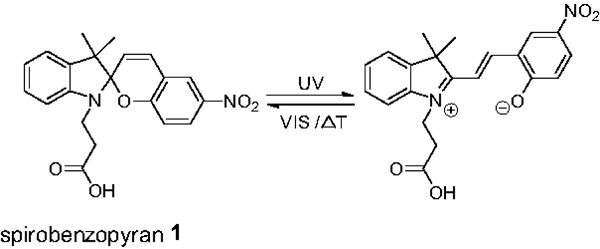通过结合表面接枝和修改后的过程光敏感膜的制备
Summary
一种等离子体诱导聚合反应过程被描述为在聚合物膜的表面引发聚合反应。与光致变色物质的接枝聚合物的进一步修改后的呈现与开展的光响应膜渗透性测量的协议。
Abstract
为了修改商业可用的轨道边缘的聚合物膜的表面张力,表面引发聚合反应的过程被呈现。从膜表面的聚合反应是由等离子体处理的膜中,接着在膜表面具有2 – 羟乙酯(HEMA)的甲醇溶液反应诱导。特别注意的是考虑到工艺参数对等离子体处理的表面上的聚合反应之前。例如,等离子体处理对不同类型的膜( 例如聚酯,聚碳酸酯,聚偏二氟乙烯)的影响进行了研究。另外,表面接枝膜的依赖于时间的稳定性示出由接触角测量。当接枝聚(2 – 羟乙基甲基丙烯酸酯)(PHEMA),以这种方式,表面可进一步通过与所需物质的羧酸功能的聚合物的醇部分酯化改性。这些反应,因此可用于对膜表面的官能化。例如,在膜的表面张力可以改变或可以被插入期望的功能所呈现的光响应性。这表现在与这导致了光响应性膜的羧酸官能spirobenzopyran单元反应PHEMA。溶剂的选择起着在修改后的工序的主要作用,并更详细地在本文中进行了讨论。这样的官能化膜的渗透性测量使用Franz池与外部光源进行的。通过改变光的波长从可见光到紫外光范围内,水的咖啡因溶液的渗透性的变化被观察到。
Introduction
材料的等离子体改性已成为许多工业领域一个重要的过程。表面和表面官能化,而 不改变该材料的整体性质的清洗已在等离子体处理在表面科学1-8必不可少的过程。
聚合物的等离子处理结果在均裂键的断裂。这导致了聚合物材料的一个边和自由基丰富的表面的形成。通过采用等离子体含有氧分子,表面变得富氧从而更亲水9-11。然而,表面的亲水性并不稳定随着时间的推移12。为了提高长期稳定性,等离子体处理的表面可进行化学后或在等离子体处理13-15修改。通常通过添加反应性单体物种进入气相中的等离子体处理进行该处理;这些单体聚合,然后从聚合物表面产生自由基。如果与一个非易失性单体进行化学处理,该聚合物接枝有等离子体改性后发生。为了执行控制接枝基团在表面上形成后,等离子体的设置被描述,其允许从所述表面在溶液中在控制条件下12,16等离子体引发的表面诱导聚合。
这次报告的重点是轨道边聚合物膜12,17的修改。通过修改这些膜的表面张力,透气率可变化12。这种清洁和快速的过程可以创建非常薄的层(<5 nm)的,涵盖整个膜表面不改变聚合物膜的大部分财产。由于在等离子体处理磨边,轨迹一柄膜的孔径增大略12。磨边率dependi纳克的聚合物上,并具有线性特性。
当使用具有反应性官能团的单体,接枝聚合物可进一步官能化。这表现在一个PHEMA接枝膜用羧酸功能化的螺吡喃的修改后的。这导致光致变色表面,由于螺吡喃已知变换成部花青类时用UV光照射。螺吡喃形式可以通过照射部花青形式与可见光( 图1)18,19重新建立。由于花青形式比螺吡喃状态更极性的,该涂层的表面张力可与光20被触发。在表面张力的变化会影响对水溶液的膜的渗透性阻力。的设立如何执行这些光响应膜的渗透性测试将显示在阻透性的显著变化(减少我97%不阻透性)是证明。这样的膜可以被集成在一个药物递送的设置或在智能传感系统。

图1。光异构化spirobenzopyran化合物1。
Protocol
Representative Results
Discussion
等离子体工艺产生紫色气体,该气体是由离子化的氩气。橙色则表示不希望的氮气从泄漏的存在。等离子体处理不只是在表面上形成自由基而且蚀刻膜7,12。太多的蚀刻可以显著改变孔径,这将影响到膜的渗透性。所提出的设置的受控反应条件允许提高等离子体引发的接枝方法的再现性。然而,在等离子体腔室中的膜的确切位置仍然可以在表面上形成自由基的密度影响由于等离子体的不均?…
Disclosures
The authors have nothing to disclose.
Acknowledgements
本工作由瑞士国家科学基金会( – 智能材料NRP 62)的支持。也承认是B HANSELMANN,K.凯尔,U.茨和B Leuthold的支持。
Materials
| Name of Reagent/ Equipment | Company | Catalog Number | Comments/Description |
| 2-Hydroxyethyl methacrylate, 97% | Sigma-Aldrich | 128635 | |
| Hexane 99% | Biosolve | ||
| Magnesium sulfate (MgSO4, anhydrous) | Sigma-Aldrich | M7506 | |
| Methanol, 99% | Sigma-Aldrich | 14262 | dried over molecular sieves |
| N,N-Dicylcohexylcarbodiimide, 99% | Sigma-Aldrich | D8002 | |
| Dimethyl aminopyridine, 99% | Sigma-Aldrich | 107700 | |
| Tert-butylmethylether, 98% | Fluka | 306975 | |
| Polycarbonate membrane | Whatman | Nanopore Track Etched (TE) (1.0 μm, 0.2 μm, 0.1 μm, 50 nm, 30 nm and 15 nm pore diameter; 47 mm or 25 mm membrane diameter) | |
| Caffeine (reagent plus) | Sigma-Aldrich | C0750 | |
| Franz diffusion cell (12 ml) | SES-Analysesysteme | 6C010015 | 15mm unjacheted Franz Cell, 12 ml Receptor volume, Flat ground, clear glass, stirbat and clamp |
| UV-Lamp | UV irradiation (366 nm, 15 W/m2) | ||
| White light lamp | White light irradiation (500 W bulb) | ||
| UV/Vis spectrophotometer | Varian 50Bio/50MPR | ||
| Polyester membranes | Sterlitech | PET0225100 | Polyester Membrane Filters, 0.2 μm pore diameter, 25 mmm diameter |
| Polyvinylidene fluoride membranes | Millipore | PVDF Membranes Durapore (0.22 μm pore diameter; 47 mm membrane diameter) | |
| Argon (99.9995%) | Alphagaz | ||
| Dressler Cesar RF Power Generator | Plasma chamber setup | ||
| MKS Multi Gas Controller 647C | Plasma chamber setup | ||
| MKS Mass-Flow controllers | Plasma chamber setup | ||
| Vacuubrand RE 2.5 rotary vane vacuum pump | Plasma chamber setup | ||
| Contact angle measurement device Krüss G10 | |||
| Balances Mettler Toledo AB204-S and Mettler ME30 |
References
- d’Agostino, R. . Basic Approaches to Plasma Production and Control. , (2008).
- Liston, E. M., Martinu, L., Wertheimer, M. R. Plasma surface modification of polymers for improved adhesion: a critical review. J. Adh. Sci. Technol. 7 (10), 1091-1127 (1993).
- Siow, K. S., Britcher, L., Kumar, S., Griesser, H. J. Plasma Methods for the Generation of Chemically Reactive Surfaces for Biomolecule Immobilization and Cell Colonization – A Review. Process. Polymers. 3 (6-7), 392-418 (2006).
- Hossain, M. M., Hegemann, D., Herrmann, A. S., Chabrecek, P. Contact angle determination on plasma-treated poly(ethylene terephthalate) fabrics and foils. Appl. Polymer Sci. 102 (2), 1452-1458 (2006).
- Guimond, S., Hanselmann, B., Amberg, M., Hegemann, D. Plasma functionalization of textiles: Specifics and possibilities. Pure Appl. Chem. 82 (6), 1239-1245 (2010).
- Lymberopoulos, D. P., Economou, D. J. Modeling and simulation of glow discharge plasma reactors. Journal of Vacuum Sci. Technol. A Vacuum Surf. Films. 12 (4), 1229-1236 (1994).
- Hegemann, D., Brunner, H., Oehr, C. Plasma treatment of polymers for surface and adhesion improvement. Nuclear Instr. Methods Phys. Res. B Interact. Atoms. 208, 281-286 (2003).
- Øiseth, S. K., Krozer, A., Kasemo, B., Lausmaa, J. Surface modification of spin-coated high-density polyethylene films by argon and oxygen glow discharge plasma treatments. Appl. Surf. Sci. 202 (1-2), 92-103 (2002).
- Choi, W. -. K., Koh, S. -. K., Jung, H. -. J. Surface chemical reaction between polycarbonate and kilo-electron-volt energy Ar[sup + ] ion in oxygen environment. J. Vacuum Sci. Technol. A Vacuum Surf. Films. 14 (4), 2366-2371 (1996).
- Kitova, S., Minchev, M., Danev, G. RF plasma treatment of polycarbonate substrates. Optoelectron. Adv. Mater. 7 (5), 2607-2612 (2005).
- Friedrich, J. F., Mix, R., Schulze, R. D., Meyer-Plath, A., Joshi, R., Wettmarshausen, S. New plasma techniques for polymer surface modification with monotype functional groups. Plasma Process. Polymers. 5 (5), 407-423 (2008).
- Baumann, L., et al. Tuning the resistance of polycarbonate membranes by plasma-induced graft surface modification. Appl. Surf. Sci. 268, 450-457 (2013).
- Hegemann, D., Hossain, M. M., Balazs, D. J. Nanostructured plasma coatings to obtain multifunctional textile surfaces. Prog. Org. Coatings. 58 (2-3), 237-240 (2007).
- Gengenbach, T., Vasic, Z., Li, S., Chatelier, R., Griesser, H. Contributions of restructuring and oxidation to the aging of the surface of plasma polymers containing heteroatoms. Plasmas Polymers. 2 (2), 91-114 (1997).
- Gengenbach, T. R., Chatelier, R. C., Griesser, H. J. Characterization of the Ageing of Plasma-deposited Polymer Films: Global Analysis of X-ray Photoelectron Spectroscopy Data. Interface Anal. 24 (4), 271-281 (1996).
- Hirotsu, T., Nakajima, S. Water ethanol permseparation by pervaporation throught the plasma graft copolymeric membranes of acrylic acid and acrylamide. Appl. Polymer Sci. 36 (1), 177-189 (1988).
- Baumann, L., de Courten, D., Wolf, M., Rossi, R. M., Scherer, L. J. Light-Responsive Caffeine Transfer through Porous Polycarbonate. Appl. Mater. Interf. 5 (13), 5894-5897 (2013).
- Minkin, V. I. Photo-, thermo-, solvato-, and electrochromic spiroheterocyclic compounds. Chem. Rev. 104 (5), 2751-2776 (2004).
- Berkovic, G., Krongauz, V., Weiss, V. Spiropyrans and spirooxazines for memories and switches. Chem. Rev. 100 (5), 1741-1753 (2000).
- Vlassiouk, I., Park, C. -. D., Vail, S. A., Gust, D., Smirnov, S. Control of Nanopore Wetting by a Photochromic Spiropyran: A Light-Controlled Valve and Electrical Switch. Lett. 6 (5), 1013-1017 (2006).
- Baumann, L., et al. Development of light-responsive porous polycarbonate membranes for controlled caffeine delivery. RSC Adv. 3 (45), 23317-23326 (2013).
- Nicoletta, F. P., Cupelli, D., Formoso, P., De Filpo, G., Colella, V., Gugliuzza, A. Light Responsive Polymer Membranes: A Review. Membranes. 2 (1), 134-197 (2012).

